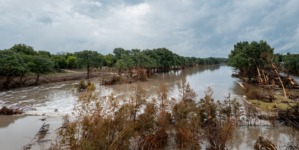-
Trump administration seeks to lift limits on SoCal immigration raids - 13 mins ago
-
Jeffrey Epstein Files: Lara Trump Teases Evidence Update from Trump Administration - 15 mins ago
-
There’s Still Hope for PEPFAR - 25 mins ago
-
FEMA Fraud Scam Warning Issued After Texas Floods—What To Know - 50 mins ago
-
Hollywood executive’s son dies in jail ahead of possible murder trial - 55 mins ago
-
Zelensky Announces Plan for Major Government Shake-Up in Ukraine - about 1 hour ago
-
Zohran Mamdani Reacts to Andrew Cuomo Reportedly Staying in NYC Mayoral Race - about 1 hour ago
-
California sues over Trump withholding of $6.8 billion in education funds - 2 hours ago
-
NPR and PBS Face Federal Funding Cuts: What to Know - 2 hours ago
-
Trump is Undoing Climate Action. Can Clean Energy Investments Survive? - 2 hours ago
How you can help the incarcerated firefighters battling L.A. wildfires

In any given year, up to 30% of the state’s wildfire-fighting force earns as little as $26.90 for a 24-hour shift. That’s because they’re prisoners in the California Department of Corrections and Rehabilitation, and more than 900 of them have helped battle the wildfires ravaging Southern California this week.
Behind bars, firefighting is a coveted job. But the blazes menacing L.A. right now have reignited debates around the state’s reliance on low-paid prisoner labor — and on some social media sites, people have begun asking how they can help.
The Los Angeles-based Anti-Recidivism Coalition, a nonprofit dedicated to ending mass incarceration, started a fundraiser on Friday to support the fire crews of California’s prisons. By Saturday morning, they’d already pulled in more than $40,000, according to their executive director, Sam Lewis.
Some of the money will go to necessities the prisoners have requested — such as new boots and other gear, Lewis said.
“Whatever they need, we’ll purchase,” he told The Times. “We’re ordering 40 boots today.”
Whatever money is left over after the blazes Lewis plans to put toward scholarships for formerly incarcerated firefighters or divvy up and donate to individual prisoners’ commissary accounts.
Founded by Hollywood producer Scott Budnick, ARC runs programs inside several prisons and two of the state’s minimum-security fire camps — one in Pine Grove, and the other in Georgetown.
According to Amika Mota, who worked as a firefighter in California’s Chowchilla prison before her release in 2015, during major fires prisoners do a lot of preventive and protective work, like clearing brush or cutting gaps in the vegetation to slow the spread of flames.
“But they are also absolutely fighting fire as ‘active nozzles,’” she told The Times. “It just depends.”
Outside of wildfire season, she said, their duties included putting out structure fires and responding to overdoses and vehicle crashes.
In recent years, prison reform and the COVID-19 pandemic have shrunk the pool of eligible inmates. In 2005, there were 4,250 inmate firefighters. By last summer, there were fewer than 1,800, housed in 35 Conservation (Fire) Camps across the state.
Last year, proposed budget cuts would’ve shuttered five camps in L.A. County, though the governor later took those camps off his list of cuts after local leaders raised concerns.
While they can make more than $26 a day during wildfire season, according to CDCR’s website inmate firefighters typically make $5.80 and $10.24 per day. When they’re responding to active emergencies, they get another $1 an hour from Cal Fire.
Even so, fighting fires is one of the best-paying prison jobs available — and it also gives qualifying prisoners a chance to chop time off their sentences.
“Every single firefighter that is out there right now, I’m sure they’re proud to be there,” Mota said. “But also every single one of those people has signed away their rights for any sort of compensation if they die on the fireground.”
Anyone interested in supporting incarcerated firefighters can visit the ARC website and write “firefighter fund” on their donations.
The Marshall Project staff writers Jamiles Lartey and Shannon Heffernan contributed to this report.
Source link

















